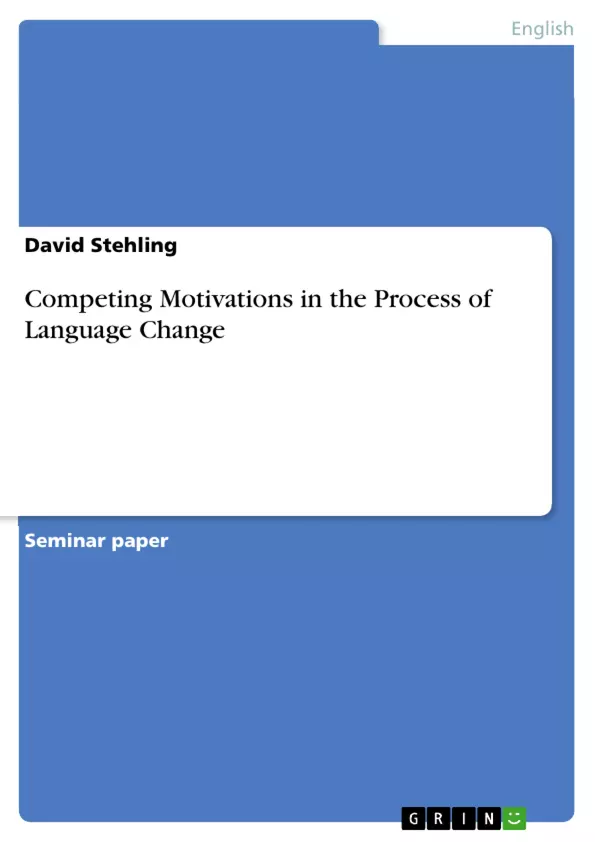Language change is a steadily continuing process. Languages were changing 2000 years ago. They are changing today and they will certainly be changing in the future. So we are able to determine different steps in the development of the English language: roughly speaking, Old English, Middle English, and Modern English. All of them are different from each other in terms of semantics, phonology, or morphology. In this manner, morphological and syntactic, phonological, lexical and semantic characteristics of a particular language are altering all the time. These processes may happen consciously or unconsciously. They may be perceived by the speakers of the respective language or they may be not. However, this process is always going on.
Furthermore, there are lots of motivations causing those changes. As an example, the ambition to ease pronunciation – that is, the reduction of effort that is necessary for moving the speech articulators – causes changes in phonology. The contact between several languages may cause lexical and semantic change as well as phonological change. Social pressures may be equally influential. Lexical items, additionally, may take over grammatical functions losing their original meaning due to frequent usage of the particular word or phrase. Thus, a language, as will be explained in this paper, is generally shaped and altered by using it.
In fact, a number of linguists claim that language change is caused by competing motivations, which “[...] can never all be satisfied at once.” This seminar paper deals with the processes of language change and these competing motivations. Hence, the various types of language changes – lexical and semantic, morphological and syntactic as well as phonological changes – will be defined and described. Furthermore, the theories of ‘Lexical Diffusion’, ‘Grammaticalization’, the ‘Invisible Hand Phenomenon’, and, finally, the sociolinguistic aspects of language change are taken into consideration. This work, however, does not meet the claim to provide a complete illustration of language change. It is rather an overview of the different motivations influencing and shaping a language steadily.
Inhaltsverzeichnis (Table of Contents)
- Introduction
- Types of Language Change
- Lexical and Semantic Change
- Morphological and Syntactic Change
- Phonological Change
- Theoretical Approaches to Language Change
- Lexical Diffusion
- Grammaticalization
- The Invisible Hand Phenomenon
- Sociolinguistic Aspects of Language Change
- Conclusion
Zielsetzung und Themenschwerpunkte (Objectives and Key Themes)
This seminar paper aims to examine the processes of language change and the various motivating factors that drive these changes. It focuses on different types of language changes, including lexical and semantic, morphological and syntactic, as well as phonological changes. The paper also explores theoretical approaches to language change, such as Lexical Diffusion, Grammaticalization, and the Invisible Hand Phenomenon, as well as sociolinguistic aspects of language change.- Types of Language Change: The paper identifies and describes various types of language change, including lexical, semantic, morphological, syntactic, and phonological changes.
- Theoretical Approaches to Language Change: The paper examines theoretical frameworks for understanding language change, such as Lexical Diffusion, Grammaticalization, and the Invisible Hand Phenomenon.
- Motivations for Language Change: The paper explores the various factors that motivate language change, such as the desire for ease of pronunciation, contact between languages, and social pressures.
- Sociolinguistic Aspects of Language Change: The paper considers the influence of social factors on language change, including the role of prestige and language variation.
- Grammaticalization: The paper explores the process of grammaticalization, where lexical items become grammaticalized and take on new functions.
Zusammenfassung der Kapitel (Chapter Summaries)
Introduction
This chapter introduces the concept of language change as a continuous process that has shaped the development of languages, including English. It highlights the diverse ways in which languages evolve, including changes in semantics, phonology, and morphology.Types of Language Change
Lexical and Semantic Change
This chapter examines the most noticeable changes in a language, including the addition of new words (through borrowing, word formation, and neologisms) and the alterations in the meanings of existing words (through processes like broadening, narrowing, meliorating, and pejorating).Morphological and Syntactic Change
This chapter focuses on changes in the structure of words, including the reanalysis of morphemes and the influence of analogy on morphological rules. It also discusses the process of grammaticalization, where lexical items become grammaticalized and lose their original meaning, gaining a grammatical function.Phonological Change
This chapter delves into the process of phonological change, examining how it affects the phonological system and phonetic nature of sounds. It distinguishes between syntagmatic and paradigmatic changes, exploring how sound changes can influence the pronunciation of similar words and how modifications in the phonological system impact a language's overall sound structure.- Arbeit zitieren
- David Stehling (Autor:in), 2010, Competing Motivations in the Process of Language Change, München, GRIN Verlag, https://www.hausarbeiten.de/document/205526


